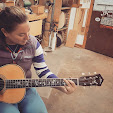Dean greeted us at the door, complete with a huge, welcoming smile. After general introductions, we handled the most important business first. My dad had been to visit Dean a couple of weeks ago and, immediately after returning to his shop, trunk packed full of gorgeous curly maple, began making Dean a guitar from some of the most beautiful pieces Dean sent him home with that trip.

 |
| Curly maple back and sides, Appalachian spruce top, koa binding. |
All of the wood from Dean's shop is SmartWood certified, which I think is pretty cool. The SmartWood certification, given by the Rainforest Alliance, ensures that sustainable forestry practices are set in place with each log that is harvested. Given Gibson's trouble with importing illegal materials, it is encouraging to know that they are taking extra strides to ensure their maple supply comes from well-managed forests. I also appreciate being able to make instruments from such materials, so it was really a treat to see what types of wood he had in his shop.
While we toured the buildings that made up Electric Hardwoods, I chatted with Dean's friend Tim. The neat thing I learned about Dean during my visit, is that I noticed many parallels in his and my dad's personalities. Generous and friendly, happy to entertain visitors, and LOVES beautiful wood. Tim told me that, like most folks living in the mountains full of coal in Southwest Virginia, Dean originally worked in the mines to provide for his family, but he had always loved trees and went out on his days off to look for exciting trees. He began harvesting some, and then traveled around to lumber yards purchasing, milling, and reselling the most beautiful boards. According to Tim, Dean's mom called up Gibson, many years ago now, and asked if they were in the market for some curly maple. At the time, they were and Electric Hardwoods began.
 |
| Sawdust pile... |
With each room we visited, my dad chose curly maple boards for mandolin backs, spruce boards for guitar and mandolin tops as a trade for the guitar he had given Dean, and I perused the burn pile for materials for ukuleles and cutting boards. It gives me great pleasure to use scraps to make something useful and beautiful, so I stocked up while I had the chance. The company sets out the pieces of wood not suitable for an instrument in a pile on the side of the road. According to the employees, it disappears quickly; neighbors take it for fire wood, or what ever they want, really. Tim and Jesse, another employee, helped me load the back of Tim's truck full of the prettiest pieces in case anyone came along to snag them to stuff into their wood stoves. Also, the sawdust produced by the mill is directed into a grey trailer, similar to those ominous looking classroom-buildings sometimes used by schools when they are renovating or have overcrowding issues. Locals are invited to take as much sawdust as they want for their horse stalls, or other farm uses. It is endearing to see how much this little company provides for their community, where many organizations would use such opportunities to turn a profit.
The atmosphere within Dean's operation is so warm and friendly. All of the employees, of which there are maybe ten, seem to enjoy their job, and were all willing to step in and find more wood we might be interested in, clambering back in the stacks to present the best ones. Several young boys would dart around the outskirts of our wheeling and dealing, staying out of our way while still getting their work done. I was thinking that a couple of those guys looked a little bit young to not be getting an education, but Tim explained to me that Dean lets several neighbor boys come help after school. It is always exciting to me to meet someone so kind and generous with his time and efforts. We truly had a great time visiting his shop. I presume Gerald's car however, might have held a different sentiment, as we stuffed it's whole back end full of boards and then insisted it drive us back to civilization (which was a quite a ways down the curvy road if we are being honest).
 |
| My new pals Tim and Dean! (Side note, check out where Dean made my dad sign his guitar with a Sharpie) |
 |
| Most of the crew: Josh, Jesse, Chris, Heath, and Dean. (And they said I wouldn't remember their names) |
Finally, if you are even still reading, I am excited to report that I have the body of a ukulele together with the sassafras Dean sent home with me. I think it is the best wood I have ever worked with, as it smells delicious, in my opinion anyway; my dad complains that it makes the whole shop smell. I am pretty sure I wold prefer that sweet, herbal tea smell over catalyzed varnish any day. Check back tomorrow, I will add a picture. It is currently snowing and I don't want to skid out to the shop and take a picture for you just now. Sorry.








